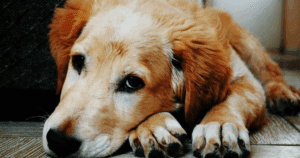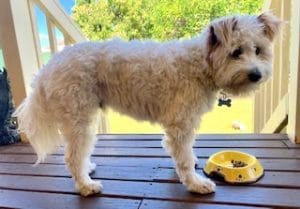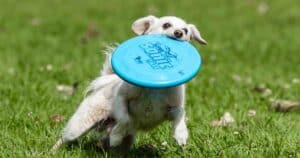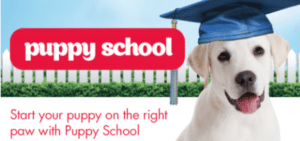

There are many ways that owners encourage bad or unwanted behaviour with their dogs without realising it, including reinforcing anxiety in their dogs as well many other common dog behaviours.
Known as Inadvertent Reinforcement, this is commonly seen when an owner is trying to stop a dog from jumping up on them or barking at the back door by pushing them down or yelling out to their dog ‘to be quiet’, for example. Whilst most owners think this is teaching the dog what NOT to do, it is in fact rewarding the dog for that behaviour by giving them what they actually want – our attention or touch. You can read more about that here.
I find that this also regularly occurs with owners reinforcing anxiety in their dogs, which can make solving this problem difficult. Often I only have to watch the owner’s own reactions or body language when a potential anxiety-causing situation occurs to see how and why the dog is being encouraged to act this way.
This applies to both fear-based aggression (dog-to-dog or dog-to-human aggression) and ‘events’ or loud noises that can frighten our dogs such as thunderstorms, fireworks, groups of children playing or approaching, big dogs approaching etc.
Instead of keeping calm and conveying to our dog that everything is okay in a confident “I’ve got it under control, so you don’t need to worry about it” way, some owners either also panic (such as seeing a bigger dog approach and frantically picking up their dog) or, (if a dog is anxious over a noise or incident), picking them up, hugging them, talking in baby-like voices and trying too hard to soothe them. All of this an actually signal to your dog that everything is ‘not’ alright because you too are panicking or, at the very least, reacting strangely when the threat is present.
We tend to think we are helping to calm them down and, whilst it might stop them barking or whimpering temporarily, what we have actually done is potentially reinforce their anxiety by demonstrating that they did indeed have something to be frightened. So, the next time the same situation occurs, it is no wonder that the dog displays that same behaviour and that it starts to get even worse a since they will feel not only do they have no control over the situation, neither do you!
For anxious dogs, I’m not saying that we simply ignore their fear but that we are very conscious of how we respond. We can certainly acknowledge they are feeling anxious and calmly reassure them in a quiet, firm and confident voice that ‘it’s okay’ and calmly get them out of the situation or try to divert their attention with a more positive activity.
For example, in the case of thunderstorms or fireworks, dogs can often smell and hear the rumble of a storm coming long before we can. So as soon as you start to see any early warning signals that your dog is starting to feel stressed or anxious (becomes quiet, tail drops between legs, licking lips, looking around nervously etc.), then not only try to block out the noise by pulling down blinds or putting on some music, you could start to do some obedience exercises to focus their attention on you, or calmly ask them to lie down in their bed and give them a tasty treat or a long lasting chew if their food drive is high. If they are more play driven, it could involve playing a game of ball when they start looking anxious and continue this on through the storm.
That way, rather than having their fear reinforced by you trying to physically or vocally calm them down, they have something more positive to focus on. This approach can also form part of a wider desensitisation program that starts to help create a positive association with what was once a negative situation.
In the case of a dog being fearful of other dogs or people, when you see that big dog approaching on your walk, you must avoid panicking and picking them up, and instead, calmly get their attention back to you/call them over and cross the road or simply turn around and walk away in another direction. What this does is give your dog a very functional reward (ie: distance from their potential ‘trigger’ which is what any dog really wants) and then you can given them a secondary reward using treats, praise or play if they keep calm and walk on or away with you. The key in this situation is ensuring you distract and distance your dog before they or you react.
Dealing with fear-based aggression requires specific knowledge on what to look out for and how to respond. This article will help you to understand where aggression comes from, whilst this article and video shows how to positively get your dog away from their ‘trigger’ of another dog, person or object.
If you are dealing with anxiety in general in your dog, have a read of this article. In response to events like fireworks or thunderstorms phobias, there are a number of techniques and tools to help which can be found here, while some tips to help with Separation Anxiety can be found here.
Medium to high levels of anxiety are also likely to require medical intervention. This is why it is so important to talk to your Vet or Vet Behaviourist as soon as you suspect something is wrong.
It is up to us to be consistent, fair and competent leaders to our dogs, which means we do of course provide them with the comfort and support they require, but that we do not make the situation worse by reinforcing their fears. Act as normally as possible in these situations, and definitely no yelling at them to be quiet or toughen up. It’s about taking their attention away from the ‘threat’ before their anxious response kicks in and trying to instead create a positive association with their ‘triggers. I would encourage you to seek the services of an experienced trainer to help should the problem be at a level that is causing you and your dog stress and before it gets worse.
About the Author: Lara Shannon is a certified dog behaviourist and trainer, pet food nutrition specialist, Executive Producer and Host of Pooches at Play on Channel 10 and editor of Poochesatplay.com. Lara also runs her own dog training business in Melbourne’s Bayside area and is the Author of World of Dogs and Eat, Play, Love (Your Dog).

Treating Noise Phobia in dogs and cats



Choosing the right puppy school



Get your paws on Lara Shannon’s best selling books ‘Eat, Play, Love (your dog) and World of Dogs.
Available in Australia, USA, UK and Canada.